All Warmed Up: The Early Days of Car Heaters
With much of the United States and Canada recently in the icy grip of a polar vortex, and many regions experiencing sub-zero temperatures (that’s 0 degrees on the Fahrenheit scale, about minus 18 on the Celsius scale for you folks north of the border), it may be an appropriate time for a look into the history of car heaters.
The first motorcars, appropriately termed horseless carriages, were generally open, and like horse-drawn carts and wagons they had no protection from the elements. “Brass era” publications show advertisements for “automotive apparel,” i.e. heavy coats, gloves, and hats, as well as “storm aprons,” essentially ponchos big enough to cover all of the passengers.

You may note that Margaret A. Wilcox was the first to invent a car heater, and that’s true, in a manner of speaking. While she did patent a system that directed air through the engine, heating it, and then routing it to the passenger compartment, the “cars” her 1893 invention warmed were railroad cars, not automobiles. I suppose that conceptually it is the basis for the way early motorcars and later air-cooled automobiles pulled passenger compartment heat from heat exchangers on the exhaust system, but I doubt Ms. Wilcox ever saw an automobile before she filed her patent application. The system did warm railroad passengers, but it was relatively primitive. Without the system they froze; with it, they were roasted.
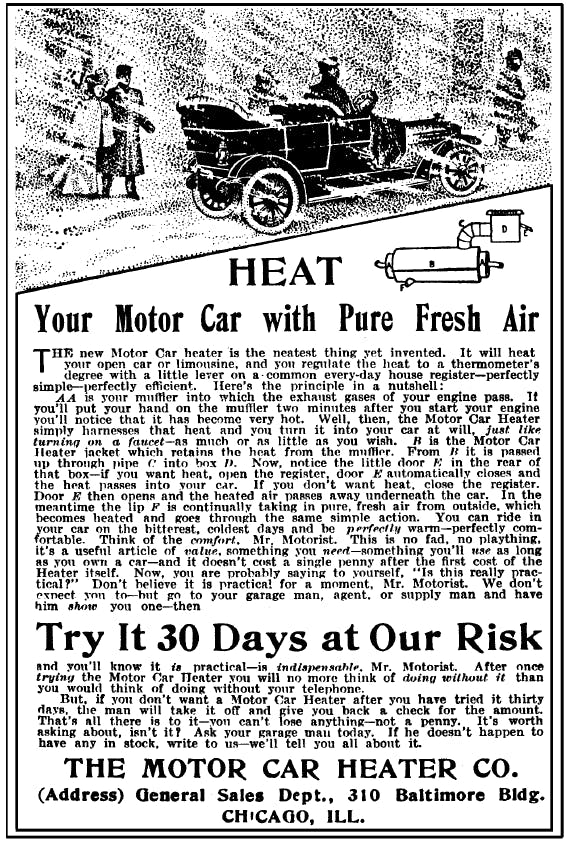
Depending on which source you read, it was either Cadillac in 1906 (or 1907 per some sources) or Hudson in 1913 that first introduced a fully-enclosed automobile. To keep warm, early motorists did what they had done with animal-powered conveyances; they would preheat bricks or soapstone on the oven at home and place them in dedicated hotboxes inside the passenger compartment.
If you think heated steering wheels are a modern accessory, you might be surprised to know that some early electric car builders wrapped heating elements around their steering wheels.

An improvement over hot bricks was the introduction of portable coal-burning heaters, made of galvanized iron with asbestos linings and brass handles for portability. A purpose-manufactured brick of coal (or charcoal) was placed in a drawer in the heater after it was prepared for use in a live fire, presumably a wood- or coal-fired oven at home. After the flame died down, the hot coals were said to burn without odor or smoke. Fortunately, even though automobiles were being enclosed, they weren’t very airtight, so perhaps carbon monoxide from the burning coal wasn’t an issue. One brick was said to be able to heat the passenger compartment for several hours. When heat was no longer needed, the hot coal could be doused with water and reused later.
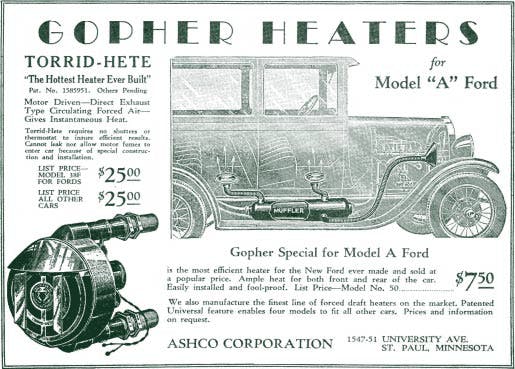
Such portable heaters required preparation ahead of time as well as moving the coals and heaters in and out of the cars. On-board heaters would be much more convenient. Since many early automobiles were air-cooled, attention was given to recovering waste heat from the exhaust system. At least as early as 1907, exhaust gas heaters were sold as automotive accessories. As seen in a period advertisement, one of those designs incorporated a metal jacket around the muffler through which air could be heated and supplied to the passenger compartment via grates in the floor.
In some cases the cabin was heated passively, through convection, and in other cases air was forced through the system, either with an air intake funnel behind the engine fan or actively with an electric blower. A more sophisticated heat exchanger design routed the exhaust gases through bundles of tubes. Heat could be controlled in very rudimentary fashion with valves whose handles were typically mounted on the car floor. Those valves controlled the flow of exhaust gas through the heat exchangers.

As an aftermarket accessory, these early heaters were not very practical. They were hard to retrofit into existing passenger compartments, and sometimes leaked exhaust into the cabin, causing some deaths due to carbon monoxide poisoning. A safer way of using the engine’s waste heat was with manifold heaters, popular with Ford Model A owners. A cast iron duct routed air over the exhaust manifold and into the cabin via a port in the firewall. Enough Model As are still on the road that manifold heaters are still being made, though now they are made of aluminum.
In 1933, after it introduced V-8 power for the masses, Ford developed an in-dash heater for those cars, though it still used exhaust as a heat source. Constructed like steam boiler, hot exhaust was directed into two dozen 13-inch-long flues around which flowed fresh air. The outlet of the heater was installed in the dashboard in front of the passenger. A button at the driver’s feet regulated the heat via an intake valve upstream of the flues.
None of the early exhaust-based heaters had provisions for mixing fresh air with the heated air, so in 1940, Ford had Novi Equipment develop an integrated manifold heater that could mix the heat with fresh air.

Also in the mid-1930s, General Motors’ Delco division developed a clever heating system that duplicated the steam radiators used to heat many homes and buildings. A boiler was located at the outlet of the muffler. The boiler was charged with a very small amount of water, just one ounce, so when the car was started, the heat from the 900°F (482°C) exhaust gases would immediately vaporize that water into steam, causing it to rise into the heater core where an electric fan would blow the heat into the cabin. From the heater core, the steam pipes routed the water vapor through the car’s radiator to condense it back to water.
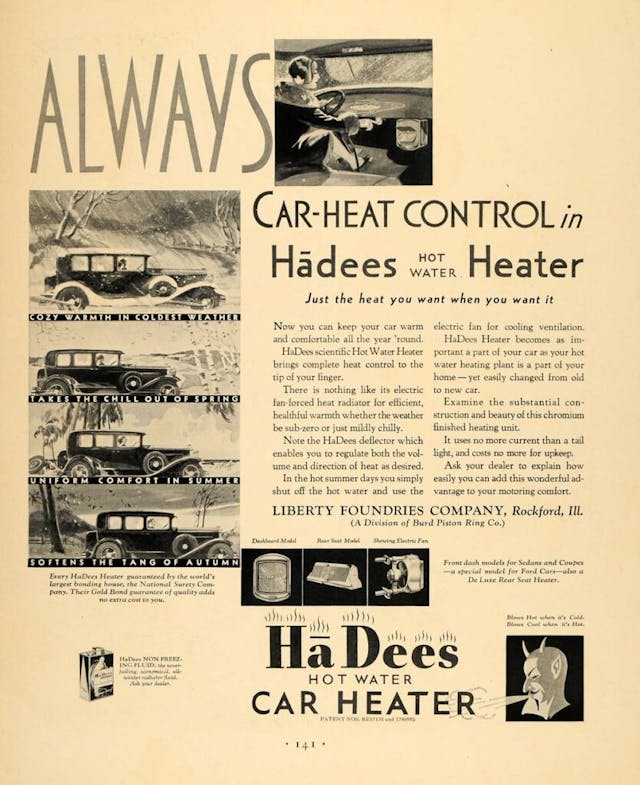
If you are wondering why the auto industry didn’t use the hot water in the cooling systems of water-cooled engines, that’s because exhaust-based heaters could discharge heat at a quite toasty 200°F (93°C) and exhaust gases are hot as soon as you start the engine, unlike engine coolant that has to heat up. However, by the mid 1920s, water pumps and thermostats had gotten reliable enough at regulating engine temperature to allow for hot coolant to be used to heat the passenger compartment. The first coolant-based heaters were aftermarket devices, and it wasn’t unusual for owners to transfer their heaters when they replaced cars.

In the winter of 1927-28, A.B. Arnold fabricated a prototype hot water heater for the Ajax car owned by another Arnold whose initials were also A.B., Arnold B. Modine. Modine had founded Modine Manufacturing in 1916, first making the Spirex-branded radiator for tractors and then supplying Ford with the Turbotube radiator for Model Ts. Incidentally, it was Modine Manufacturing that built the first vehicular wind tunnel in 1941, to test radiators and car heaters.
Modine attributed his success to his insight that the key to managing heat in liquid-cooled engines was focusing on heating the air passing through the radiator, rather than concentrating on lowering the temperature of the coolant. A.B. Arnold took a honeycomb heater core, mounted it under the dashboard and plumbed it into the engine cooling system so that the hot coolant flowed through the core on its way to the radiator, where it would be cooled. The system impressed Modine enough that he started to manufacture it to sell to automakers.
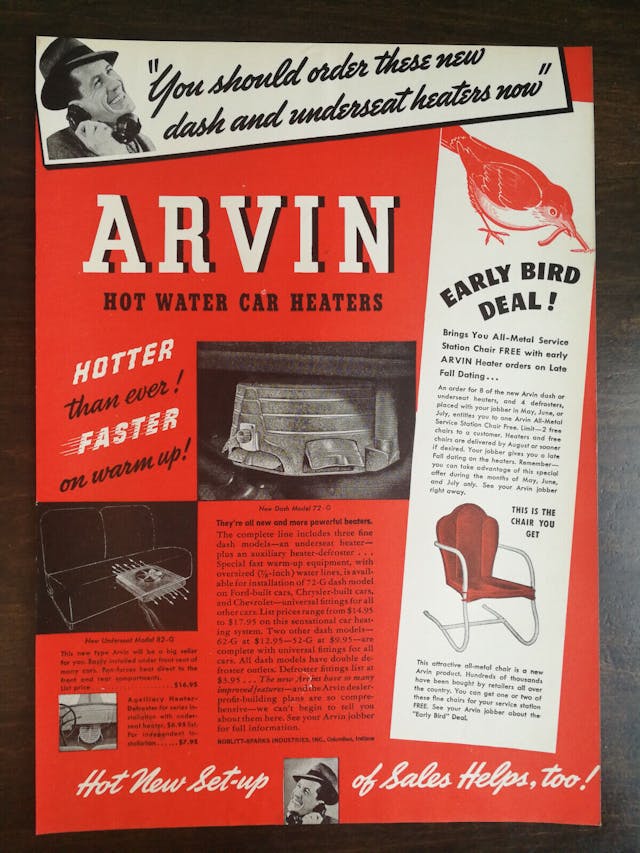
The Trane and Fedders companies, which you may recognize as makers of HVAC equipment, joined Modine in selling hot water-based car heaters, as did brands like Arvin and Ha-Dees (back in the ’30s, it was much more polite to say “hades,” than, “hell”). Major retailers like Sears and Montgomery Ward also sold aftermarket hot-water heaters. As with the Ford manifold heaters, you can buy reproductions for your period-correct restoration.
General Motors got into the picture with coolant-based heaters designed by Carl Darrah at Harrison Radiator Division, and in 1931 they introduced a heater for the rear passengers built into a footrest. Modine introduced a similar footrest design that was one of the first to mix fresh air from outside the car with the heated air. In 1933, A.B. Arnold also addressed the issue of fresh air by ducting heated air from the cowl ventilator on a Ford V-8 to the heater core mounted behind the instrument panel and then routing it from the heater core to the windshield, thereby apparently inventing the defogger.

In 1937, Nash added cabin pressurization to the mix. Filtered air was forced into heater and then to the passenger compartment, creating slightly higher air pressure inside the car. This prevented cold air from seeping in through various routes into the cabin.
It should be noted that with all of those advancements, most automakers did not offer heaters as standard equipment. It wasn’t until 1962 that hot water-based heaters became standard equipment on General Motors cars (well, except for the air-cooled Corvair, which had air forced over heat exchangers built into the exhaust system, similar to air-cooled Volkswagens and Porsches), and it wasn’t until 1968 that automakers stopped making heaters optional equipment. Newly-adopted Motor Vehicle Safety Standards required some kind of heated windshield defrosting system and the only way to do that was making heaters standard.
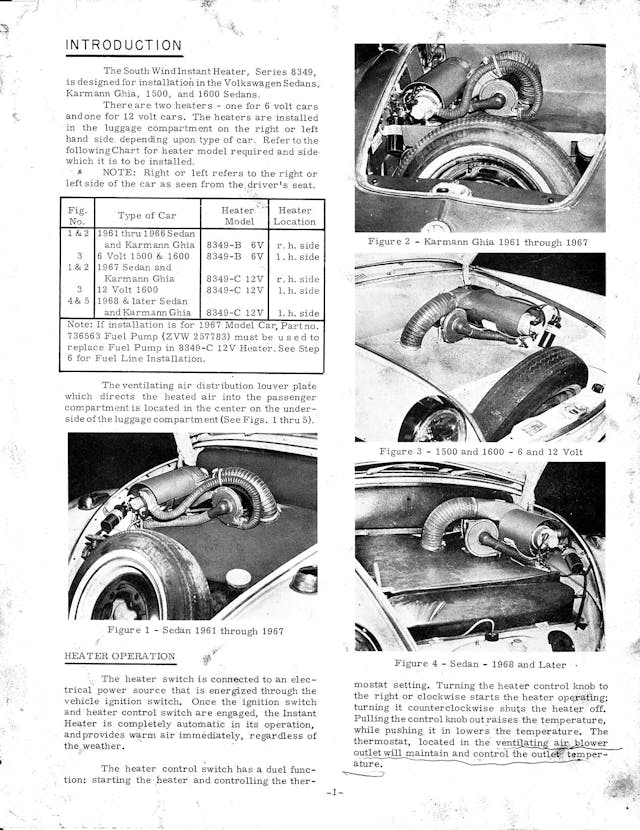
Owners of some of those air-cooled VWs, as well as over-the-road truckers, might be familiar with another heating system. In the late 1930s, the Stewart-Warner company developed a gasoline-burning passenger car heater and in the early ’60s. Working with GM’s Harrison division, they developed a gasoline-fired heater for the Corvair. Essentially a self-contained furnace, it delivered near-instantaneous heat in ample quantities. Stewart-Warner’s Southwind brand advertised them as heating up within 90 seconds. S-W sold them for Volkswagens, as did Germany’s Eberspacher. Nothing will warm the inside of a car faster than a gas-fired heater. Over-the-road truckers have used similar gas-fired heaters to keep their sleeper compartments warm without having to idle their engines for hours.
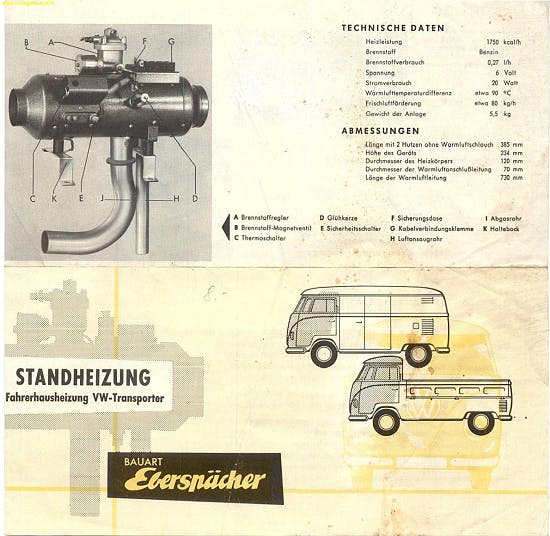
Developments like air conditioning and automatic climate control followed, and perhaps when the weather heats up this summer, we’ll take a look at the history of automotive A/C (short form: Packard, 1939). But in the meantime, if the weather outside is frightful, but inside your car it’s still delightful, you can thank folks like A.B. Arnold, A.B. Moline, Carl Darrah, and maybe even Margaret Wilcox.
***
Check out the Hagerty Media homepage so you don’t miss a single story, or better yet, bookmark it. To get our best stories delivered right to your inbox, subscribe to our newsletters.
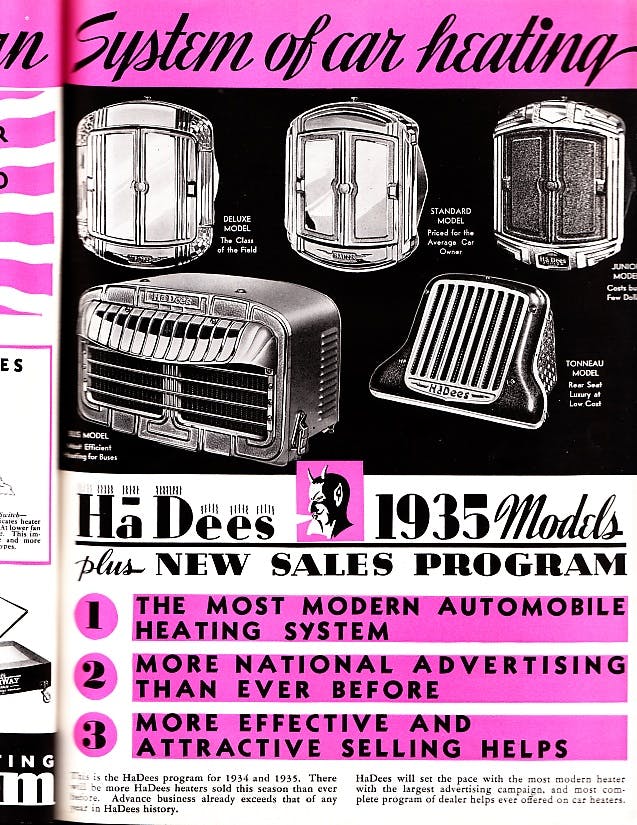


Airplanes often had gas-fired heaters due to the fact they have air cooled engines.
Many had a basic exhaust manifold heat system, either way they are necessary in the winter.
After all, they are lightly insulated (or no insulation to save weight) metal structures at high altitudes.
It gets cold.
My Maule had an exhaust manifold heat exchanger. It was nearly useless. In Winter, I dressed like I was going deer hunting when I flew that plane.
I always thought the heaters under the seat were great. I think it was a 53 Pontiac that had the heaters under the seat and later I had a 1948 Lincoln Continental. What heaters under the seat. I always hated the exhaust heater on my Volkswagen. They were renowned for rusting out. Another great invention was the defroster heater. I remember the best car I ever had with the heater in the 50s was in 1955 Chevy 210 sedan
I lived in Australia in the early 60s to the late 60s.. Cars didn’t come with heaters. They would take a heater core that was small enough to fit under the dashboard and use the hood vent better than nothing. Getting back to the VW’s I did purchase58 Volkswagen. I tried to find a gas heater but all the heaters. By this time were 12 V, I end up getting Coleman heater which was a disaster because it would frost up the windows on the inside.
I have a 1948 Chevy Fleetmaster that has two heater cores and fans. One under the dash and one under the front seat on the passenger side. They ran hose from the radiator to the first heater core then down to the one under the seat. There are two switches on the under the dash for each heater and they are two speed. The car is 99% original (including the paint) and those appear to be optional just like the engine oil filter was optional (wasn’t select for my car???).
I grew up in post WW2 Britain and thought heaters were optional extras in the 50s and 60s because Britain was broke.
It never occurred to me they were not standard in the richest country in the world.
Amazing
A very interesting story. Got to love heat from Ha-dees! I want that in my Hellcat!
In 1960, my father ordered a new Chevrolet truck in Miami. He didn’t order it with a heater, an option, thinking it was really not needed in Miami. He traded in a 1954 Chevrolet truck, bought new in New York WITH an optional heater. The dealer sold that ’54 right away, because it was a like new 1-ton pickup but also because it had a factory HEATER, rare in a truck. Also, in 1964 we bought a new Chevelle Malibu in Miami, it had a heater but no power steering. My father traded the heater for power steering with the dealer, for my sisters to drive, thinking PS was needed more! Traded in a Florida car, a ’61 Corvair Monza, NO heater.
Seat heaters…steering wheel heaters…airscarfs….auto temperature control….4-zone climate control….multisystem heat & a/c – I feel we are very soft today.
Yep, and it sure feels good!
My 1941 Plymouth was the lower cost model. It has a radio delete plate. Mopar did sell heaters (possibly dealer installed). My Plymouth has an aftermarket heater that heats the cabin but does not include any connection to the vents under the windshield, so no defroster. The car also did not include the optional turn signals. An aftermarket turn signal system was added sometime later.
My first car was a rumble seat Model A Roadster (obviously not the original owner!) and there were folks in the Model A Club that had the pictured manifold heater… but why I am writing is I like the logic of The Gopher Heater! Once your muffler rots through, one will be planted with the gophers!
Scene: Cleveland, January, 1978. Record cold winter.
My car wasn’t starting so a friend agreed to take me to work. He arrives in a beat up ‘67 Impala. As I enter, he says I should take a backseat. While closing the front door, I notice a pile of old newspaper. 😳
So I take my place in the backseat and off we go. At the first stoplight, my friend casually pulls out a lighter, grabs some newspaper, sets it on fire and tosses it on the vinyl flooring.
That was HIS heater 🤣🤣🤣
VW Beetle heaters were a bit of a crap shoot. A friend in high school had a 69 with rusted out heater boxes and a leaky sunroof that routinely had ice in the footwells and inside the windshield. My college roommate had a 73 with solid heater boxes that was comfortable in Upstate New York winters. Having lived i cold places I always scratched my head at the Californians who deleted their VW and Porsche heater boxes
Speaking of railroad passenger cars, we made several winter rail trips in the 60’s. I have no idea what fueled the system, but is was evident that the conductor’s setting were “on and off.” The cycle was 30 minutes. If you were comfortable, in 15 minutes, you’d be cold. (“On”) In 15 more minutes you’d be comfortable again, but wait another quarter hour and you’d be cold. The drill was bring a heavy coat.
The railways used steam heat with diesel power. Yes steam generators could be tricky and poor training was a problem.
We had two Chevy Vega(s) . They both had heaters, but it is my understanding that a heater was an option.
Chevy Vega; optional heater??
Heaters became standard equipment on all gm passenger cars for 1962. You could still get most models without a heater if it was ordered with the heater delete option- this was a credit option. Such cars would have blank off plates for the controls and the openings in the body where heater ductwork would enter the interior.
My friend and I bought an early ‘50’s Volkswagen to drive to work and back 30 miles each way. Summer was ok with the windows down and vents open but winter was a challenge. It took two of us to drive it, one steered and the other scraped the windshield on the inside so the driver could see. We found a gas heater in a junkyard out of an 1500 model and rigged it up. Nice and warm after that. Also that car never let us down or got stuck in the snow. We put a lightbulb in the engine compartment in winter and it fired up every morning even at 20 below F.